1. Define Clear Goals for the Program
Start with the “why.” What do you want to achieve with your internship program?
Common objectives include:
- Building a pipeline of future full-time hires
- Creating brand awareness among emerging talent
- Gaining support on short-term tech projects
- Offering mentorship and industry exposure to students
🎯 Tip: Align your goals with company values and long-term hiring needs.
2. Design a Strong Program Framework
Once you know your goals, develop a structured framework that includes:
a. Duration & Timing
- Typical internships last 8–12 weeks during summer
- Consider flexible or year-round options for greater inclusivity
b. Internship Type
- Technical Interns (e.g., developers, engineers, data analysts)
- Product & UX Interns
- Support Roles (e.g., QA, IT, DevOps, Marketing Tech)
c. Paid vs. Unpaid
- Paid internships attract stronger talent and improve equity
- Ensure compliance with local labor laws
3. Build Well-Defined Projects
Interns should work on real, meaningful projects—not just coffee runs or shadowing.
Good internship projects:
- Are scoped for the internship’s time frame
- Align with business objectives
- Allow interns to own part of the solution
- Encourage collaboration across teams
🛠️ Example: Build a prototype feature, optimize a database, automate a process, conduct user testing, or analyze product data.
4. Assign Mentors and Buddy Systems
Support is key to a successful internship. Each intern should have:
- A dedicated mentor (usually a senior or mid-level employee)
- A peer buddy to help them navigate company culture
- Regular check-ins to review progress, feedback, and challenges
💡 Tip: Train mentors to provide constructive guidance and leadership experience.
5. Create a Learning-Focused Environment
Your interns aren’t just there to work—they’re there to learn.
Include:
- Onboarding sessions and technical training
- Lunch-and-learns with different departments
- Code reviews and skill workshops
- Exposure to company tools, processes, and methodologies (Agile, DevOps, etc.)
📚 Tip: Provide access to internal documentation and encourage questions.
6. Evaluate Performance and Provide Feedback
Interns need feedback to grow—and so do your teams.
Best practices:
- Conduct mid-point and final evaluations
- Offer personalized feedback with actionable suggestions
- Collect feedback from interns on their experience
- Use structured assessments if considering full-time conversion
📈 Tip: Track intern performance and program success using defined KPIs (project outcomes, skill growth, team integration).
7. Offer Networking and Engagement Opportunities
Make interns feel like part of the team.
Ideas:
- Host team-building events, virtual meetups, or hackathons
- Include interns in daily stand-ups and planning meetings
- Give them opportunities to present their work company-wide
🎤 Tip: Let interns showcase their projects at a final presentation or demo day.
8. Plan for Conversion and Alumni Engagement
Top-performing interns often make great full-time employees.
Strategies:
- Have a structured conversion process (e.g., interviews, evaluations)
- Stay in touch with former interns through newsletters or alumni networks
- Offer return internships or early offers for graduating students
🔁 Tip: Treat internships as a long-term talent investment.
Final Thoughts
A successful internship program goes beyond just recruiting college students—it’s about building future leaders, energizing your teams, and staying competitive in the fast-paced tech world.
By structuring your program with purpose, support, and engagement, you can create an experience that benefits your company, your interns, and the broader tech ecosystem.







1 thought on “How to Structure Internship Programs in Tech Companies”
right
Comments are closed.